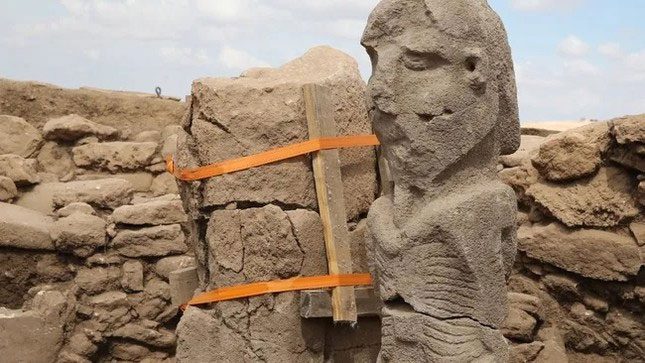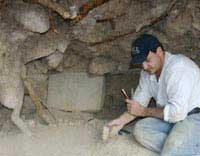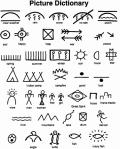Archaeologists in Turkey have unearthed a nearly 11,000-year-old statue depicting a giant man holding his genitals, alongside a life-sized statue of a wild boar. These statues were discovered at nearby sites, Göbekli Tepe and Karahan Tepe, which are among the oldest temples in the world.

This sculpture was recently discovered at Karahan Tepe. The newly found sculptures date back approximately 11,000 years. (Photo: Agency / Anadolu contributor via Getty Images).
The wild boar statue, carved from limestone, was found at Göbekli Tepe and dates back to around 8700-8200 BC. The German Archaeological Institute reported that this statue measures 1.4 meters in length and 0.7 meters in height. Archaeologists discovered red, black, and white pigments on its surface, indicating that the sculpture was once painted.
At Karahan Tepe, located about 35 kilometers from Göbekli Tepe, archaeologists uncovered a large sculpture representing a man.
According to a statement from the Turkish Ministry of Culture and Tourism, the statue depicts a man standing 2.3 meters tall, with clearly defined ribs, spine, and shoulders suggesting that this individual has passed away.
Benjamin Arbuckle, an anthropology professor at the University of North Carolina, USA, stated: “These discoveries are the latest spectacular findings that are changing our understanding of pre-agricultural communities.”
Researchers also found a small sculpture of a vulture near Karahan Tepe. Although archaeologists did not specify the age of the newly found statues at Karahan Tepe, the site itself is estimated to be around 11,000 years old and contains ancient sculptures.
Archaeologists previously believed that hunter-gatherer communities in Southwest Asia around 11,000 years ago were relatively simple, small-scale, and egalitarian. However, discoveries at Göbekli Tepe and Karahan Tepe over the past 30 years have challenged this notion.
Göbekli Tepe is a vast megalithic site featuring numerous T-shaped pillars and intricate sculptures depicting animals, abstract symbols, and human hands. According to the United Nations Educational, Scientific and Cultural Organization (UNESCO), this site may have been used for burial rituals. The presence of such a monumental and complex complex suggests that hunter-gatherer communities in the region were organized in a way that allowed them to construct great architectural works.
Researchers believe that the figure clutching his genitals may signify that this individual was an ancestor of a social group, such as a lineage or clan.
The architectural structures at Karahan Tepe and Göbekli Tepe may have been used as residences rather than temples.





















































